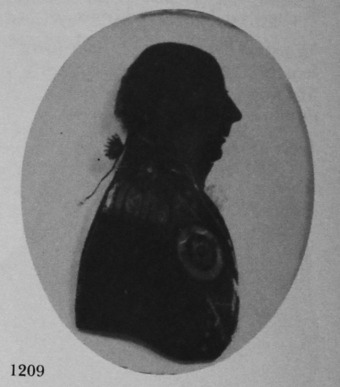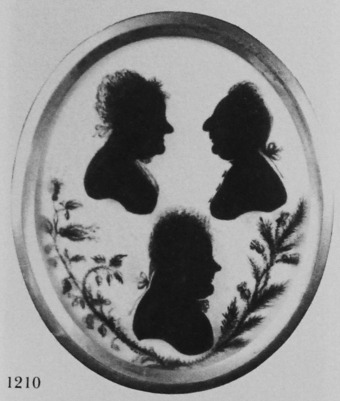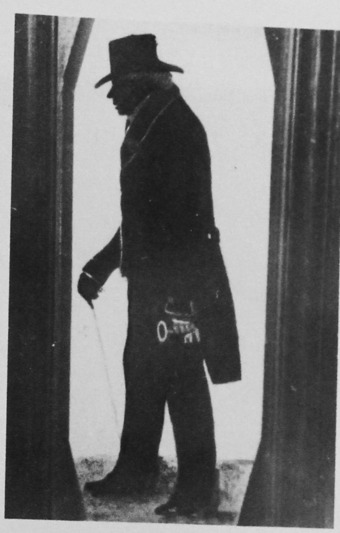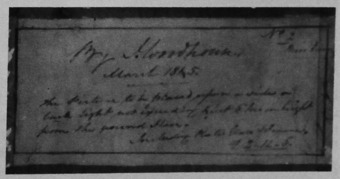Woodhouse, John (McKechnie Section 3)
Recorded by Jackson (Dictionary). Woodhouse's Trade Label No. 1 states that his main trade was that of 'painter and glazier' and that he worked at Alnwick. Woodiwiss (notebook) states that he had seen a full-length silhouette by Woodhouse, dated 4 July 1825 and taken at Newcastle, of an old woman seated at a writing table. Contemporary directories for Alnwick and Newcastle give the following entries for him: 1821-23, 'John Woodhouse, Junr: Painter, Bondgate Street, Alnwick'; 1827-1829, 'John Woodhouse, Painter in Shade, 9, Blackett Street' (in Newcastle). Since the style 'Junr' does not appear in the entries for 1827 and 1829 we can assume that his father. whose first name must have been John, died between 1823 and 1827. Although directory entries cease after 1829, we know that he continued to paint profiles during the 1830s, for Woodiwiss owned an example dated 1833.
1213
We cannot be certain whether the description 'painter' indicates that he was an artist or a house painter; probably he was the latter, since, if he was an artist, he would probably have been so described both in directory entries and on his trade label. As a glazier, he would have been able to frame his silhouettes himself.
The illustrated bust-length examples of his work appear to be of earlier date than the full-length. It is difficult to date his bust-length silhouettes with accuracy; they appear to have been painted before 1820, and some examples might date from as early as 1810. He had certainly begun to paint full-length work by 1821, for a signed example bearing this date was sold by Sotheby and Company, London, on 30 April 1973. This shows the subject (one George Wilson) in an indoor setting, with a desk, a chair, and a curtain. On the backs of some of what are apparently his later
full-length pieces, Woodhouse gave careful instructions for their hanging. Woodiwiss owned an example (the profile of a Mr Thorburn) which its possessor was asked to place 'not exceeding 5 feet on a side-light'. Another silhouette, in my collection, must be placed 'upon a side or back light not exceeding 4 ft. 6 in. in height from the ground floor'.
1213
Few of Woodhouse's bust-length profiles are available for description. Known examples are painted much in the style of Rosenberg or William Hamlet the elder. No doubt they are faithful likenesses, for Woodhouse does not seem to have flattered his sitters. Their hair is represented as wild and wiry, and the thin tye-wigs of the period are shown as thin and scrappy. Where transparency was required, Woodhouse used a needle. His bust-line finish tends to a concavity near the centre. These silhouettes are painted on convex glass and housed either in small oval frames of turned wood (more nearly circular than those used during the 1790s) or in papier mâché frames.
Most of the charm of Woodhouse's full-length silhouettes lies in the lightly painted backgrounds, which have a ghostly look, apparently achieved by light touching with an almost dry brush, while density in the background decoration is effected with a coarser brush. On the profile itself, such details as the sitter's hand, or the lining of a coat, are also rendered in this fashion. Hand formation is, however, a little clumsy, the fingers appearing rather thick and large, despite the delicate fashion in which they are drawn. Hair seems to have been drawn entirely with the needle. Woodhouse does not seem to have used the fingerprinting technique.
Although the painting of detail is not fine, these full-length silhouettes on flat glass are full of character, and, like the bust-length pieces, appear life-like. Although Woodhouse painted 'Mr Thorburn and his dog' 'from recollection', in this silhouette, as in other examples, he seems to have a keen sense of observation to which he probably owed more than to artistic training. His full-length silhouettes, moreover, are certainly seen to best advantage when his hanging instructions are followed, and the painted figure throws a true shade' against the ghostly background.
Woodhouse's full-length profiles have been seen in rather heavy frames of different types: one was in a frame of solid oak, fitted at the back for protection against a damp wall; another (in my collection) is in a wide, solid mahogany frame, canted away from the picture and with a gilt surround.
Two trade labels (both illustrated) are known. On No. 1, which is engraved, Woodhouse describes himself as a house painter and glazier at Alnwick. No. 2 is handwritten; in view of the date, and Woodiwiss' note, cited above, it may have been used in Newcastle. It reads as follows:
By J. Woodhouse March 1825
The Picture to be placed upon a side or back light not exceeding 4 ft. 6 ins. in height from the ground floor. Including the glass and frame £2-12-6d.
One illustrated silhouette is signed on the reverse.
Ills. 1209-1215

Unknown army officer
Silhouette painted on convex glass, backed with plaster
c. 1810
Frame: rounded ebonised wood, with gilt surround
Signed on the reverse, ‘John Woodhouse Junr, Alnwick.’ The sitter wears a sash and an order with a classical head in the centre of the star, surrounded with the letters ‘R.C.L.’
From the collection of the late J. C. Woodiwiss

Members of an unknown family
Group of three wilhouettes painted on convex glass, backed with plaster
c. 1810-12
3 x 2 ¾ in./77 x 70mm.
Trade Label No. 1
Frame: papier mâché
The design of a rose and thistle at the base may indicate an Anglo-Scottish marriage.
M. A. H. Christie collection

Unknown man
Silhouette painted on glass
March 1825
11 ½ x 8 1/2 in./293 x 216mm.
Trade Label No. 2
Frame: mahogany (canted), with giltwood surround
Probably painted in Newcastle. A typical full-length silhouette by Woodhouse, showing the ‘ghostly’ type of landscape background described in the text. The man’s tasselled cane was fashionable during the 1820s.
Author’s collection

Unknown man
Silhouette painted on glass
1820s
8 x 5in./205 x 128mm.
Frame: ebonised wood
Neither signed nor labelled, this silhouette is attributed to Woodhouse on stylistic grounds. Formerly in the Wellesley collection, and at that time (before Woodhouses’s work had been isolated) attributed to William hamlet the elder. The silhouette has been cut to fit its present frame.
Jean Lapworth collection

Mr Thorburn and his dog
Silhouette painted on glass
December 1833
11 ½ x 8 ½ in./293 x 216mm.
Frame: oak
The silhouette bears an inscription stating that it was painted ‘from recollection, after the demise of the subject.’
From the collection of the late J. C. Woodiwiss

Trade Label No. 1 of John Woodhouse, from the silhouette illustrated in 1210.
M. A. H. Christie collection

Trade Label No. 2 of John Woodhouse, from the silhouette illustrated in 1211.
Author’s collection
